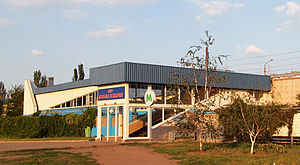반감기 양자화학법
Semi-empirical quantum chemistry method반감기 양자화학 방법은 하트리-에 기반을 두고 있다.형식주의를 고수하되, 많은 근사치를 만들고 경험적 데이터로부터 일부 매개변수를 얻으십시오.그것들은 하트리 전체에서 큰 분자를 치료하기 위해 계산 화학에서 매우 중요하다.근사치가 없는 포크 방식은 너무 비싸다.경험적 매개변수의 사용은 전자 상관 효과를 방법에 일부 포함시킬 수 있는 것으로 보인다.null
하트리-의 틀 안에서fock 계산, 일부 정보(예: 2-전자 통합)는 때때로 근사치 또는 완전히 생략된다.이러한 손실을 보정하기 위해 반감기적 방법은 파라메트리화된다. 즉, 그 결과는 일반적으로 실험 데이터에 가장 잘 부합하는 결과를 산출하는 방식으로 매개변수 집합에 의해 적합되지만, 때로는 ab initio 결과에 동의한다.null
사용된 단순화의 유형
반감기적 방법은 해밀턴의 2전자 부분이 명시적으로 포함되지 않는 흔히 경험적 방법이라고 하는 것을 따른다.π 전자 시스템의 경우, 이것은 에리히 후켈이 제안한 후켈 방식이었다.[1][2][3][4][5][6]모든 발란스 전자 시스템에 대해 확장된 후켈 방법은 Roald Hoffmann에 의해 제안되었다.[7]null
반감기적 계산은 대부분 영미분 겹침 근사치의 사용으로 인해 초기 계산보다 훨씬 빠르다.그러나 계산 중인 분자가 방법을 파라메트리징하는 데 사용되는 데이터베이스의 분자와 충분히 유사하지 않으면 그들의 결과는 매우 잘못될 수 있다.null
기본 설정 응용 프로그램 도메인
경험적 연구는 직간접적인 관찰이나 경험을 통해 지식을 얻는 방법이다.null
π전자로 제한된 방법
이러한 방법은 주기적 및 선형적으로 폴리에네스의 전자적으로 흥분된 상태를 계산하기 위해 존재한다.PPP(Pariser-Par-Porple method)와 같은 이러한 방법은 매개변수가 잘 되었을 때 π 전자 흥분 상태에 대한 좋은 추정치를 제공할 수 있다.[8][9][10]여러 해 동안, PPP 방법은 흥분된 상태 계산을 능가했다.null
방법은 모든 발란스 전자에 제한된다.
이러한 방법은 다음과 같은 여러 그룹으로 그룹화할 수 있다.
- 란타니드 복합체에 사용할 수 있는 스파클링/AM1과 같은 조정 화합물의 기하학적 형상을 예측하는 것이 주된 목표인 방법.
후자는 가장 큰 방법군이다.null
참고 항목
참조
- ^ Hückel, Erich (1931). "Quantentheoretische Beiträge zum Benzolproblem I". Zeitschrift für Physik (in German). Springer Science and Business Media LLC. 70 (3–4): 204–286. doi:10.1007/bf01339530. ISSN 1434-6001.
- ^ Hückel, Erich (1931). "Quanstentheoretische Beiträge zum Benzolproblem II". Zeitschrift für Physik (in German). Springer Science and Business Media LLC. 72 (5–6): 310–337. doi:10.1007/bf01341953. ISSN 1434-6001.
- ^ Hückel, Erich (1932). "Quantentheoretische Beiträge zum Problem der aromatischen und ungesättigten Verbindungen. III". Zeitschrift für Physik (in German). Springer Science and Business Media LLC. 76 (9–10): 628–648. doi:10.1007/bf01341936. ISSN 1434-6001.
- ^ Hückel, Erich (1933). "Die freien Radikale der organischen Chemie IV". Zeitschrift für Physik (in German). Springer Science and Business Media LLC. 83 (9–10): 632–668. doi:10.1007/bf01330865. ISSN 1434-6001.
- ^ 유기화학자들을 위한 휴켈 이론, C. A. 콜슨, B.O'Leary and R. B. Mallion, Academic Press, 1978.
- ^ Andrew Streitwieser, 뉴욕주 Wiley의 유기화학자들을 위한 분자 궤도 이론 (1961년)
- ^ Hoffmann, Roald (1963-09-15). "An Extended Hückel Theory. I. Hydrocarbons". The Journal of Chemical Physics. AIP Publishing. 39 (6): 1397–1412. doi:10.1063/1.1734456. ISSN 0021-9606.
- ^ Pariser, Rudolph; Parr, Robert G. (1953). "A Semi‐Empirical Theory of the Electronic Spectra and Electronic Structure of Complex Unsaturated Molecules. I.". The Journal of Chemical Physics. AIP Publishing. 21 (3): 466–471. doi:10.1063/1.1698929. ISSN 0021-9606.
- ^ Pariser, Rudolph; Parr, Robert G. (1953). "A Semi‐Empirical Theory of the Electronic Spectra and Electronic Structure of Complex Unsaturated Molecules. II". The Journal of Chemical Physics. AIP Publishing. 21 (5): 767–776. doi:10.1063/1.1699030. ISSN 0021-9606.
- ^ Pople, J. A. (1953). "Electron interaction in unsaturated hydrocarbons". Transactions of the Faraday Society. Royal Society of Chemistry (RSC). 49: 1375. doi:10.1039/tf9534901375. ISSN 0014-7672.
- ^ J. 포플과 D.베버리지, 맥그로우-힐, 1970년 근사분자 궤도 이론.
- ^ Ira Levine, Quantum Chemistry, Frintice Hall, 제4판, (1991), 페이지 579–580
- ^ C. J. Cramer, Essentials of Computing Chemistics, Wiley, Chichester, (2002) 페이지 126–131
- ^ J. J. P. Stewart, Computing Chemical Reviews in Computing Chemical, 1권 Eds. K. B.립코위츠와 D. B. 보이드, VCH, 뉴욕, 45, (1990)
- ^ Michael J. S. Dewar & Walter Thiel (1977). "Ground states of molecules. 38. The MNDO method. Approximations and parameters". Journal of the American Chemical Society. 99 (15): 4899–4907. doi:10.1021/ja00457a004.
- ^ Michael J. S. Dewar; Eve G. Zoebisch; Eamonn F. Healy; James J. P. Stewart (1985). "Development and use of quantum molecular models. 75. Comparative tests of theoretical procedures for studying chemical reactions". Journal of the American Chemical Society. 107 (13): 3902–3909. doi:10.1021/ja00299a024.
- ^ James J. P. Stewart (1989). "Optimization of parameters for semiempirical methods I. Method". The Journal of Computational Chemistry. 10 (2): 209–220. doi:10.1002/jcc.540100208.
- ^ Gerd B. Rocha; Ricardo O. Freire; Alfredo M. Simas; James J. P. Stewart (2006). "RM1: A reparameterization of AM1 for H, C, N, O, P, S, F, Cl, Br, and I". The Journal of Computational Chemistry. 27 (10): 1101–1111. doi:10.1002/jcc.20425. PMID 16691568.
- ^ James J. P. Stewart (2007). "Optimization of Parameters for Semiempirical Methods V: Modification of NDDO Approximations and Application to 70 Elements". The Journal of Molecular Modeling. 13 (12): 1173–1213. doi:10.1007/s00894-007-0233-4. PMC 2039871. PMID 17828561.
- ^ M. 제르너, 제2권, Eds. K. B.의 계산 화학 리뷰.립코위츠와 D. B. 보이드, VCH, 뉴욕, 313, (1991)
- ^ Nanda, D. N.; Jug, Karl (1980). "SINDO1. A semiempirical SCF MO method for molecular binding energy and geometry I. Approximations and parametrization". Theoretica Chimica Acta. Springer Science and Business Media LLC. 57 (2): 95–106. doi:10.1007/bf00574898. ISSN 0040-5744.


